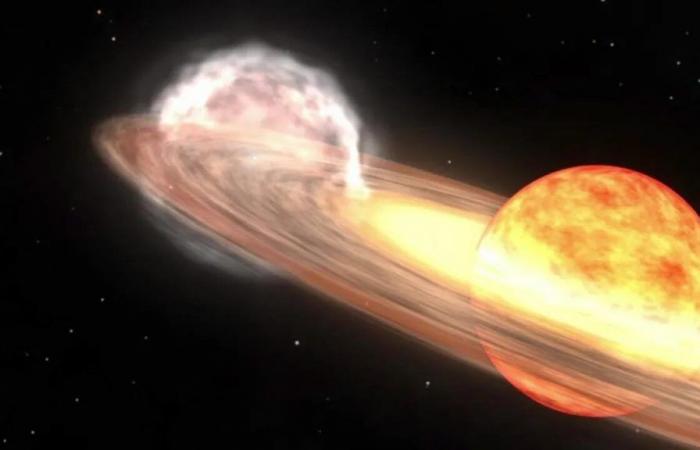To NASA and astronomers around the world awaiting a very rare event
This summer, professional and amateur astronomers around the world will observe a small constellation in the night sky. It is not the seven stars of the Corona Borealis, the “Northern Crown”, that have aroused so much interest, but a dark point between them, where anova explosion so bright that it is visible to the naked eye on Earth.
“T Coronae Borealis, nicknamed the ‘Blazing Star’ and known to astronomers simply as ‘T CrB’, is a binary system located approximately 3,000 light-years from Earth in the Corona Borealis. The system is composed of a white dwarf and an ancient red giant which is slowly being stripped of its hydrogen by the gravitational pull of its hungry neighbor.” Dr. Hounsell, an assistant nova researcher at NASA’s Goddard Space Flight Center, said: “This is a once-in-a-lifetime event that will create many new astronomers, giving young people a cosmic event to observe, ask questions and collect data.”
The head of NASA Goddard’s Astroparticle Physics Laboratory, Dr. Elizabeth Hays, said that part of the fun of observing this event is seeing the excitement among amateur astronomers, whose love of extreme space phenomena has supported a long and fruitful collaboration with NASA. The astronomers enthusiastically study the T CrB system, which is composed of a white dwarf and a red giant. The red giant’s hydrogen builds up on the white dwarf’s surface, causing pressure and heat that eventually triggers a thermonuclear explosion large enough to eject the accumulated material. This event, according to astronomers, occurs on average every 80 years.
For Don’t confuse a nova with a supernova, Dr. Hounsell explained that, unlike a supernova that destroys the dying star, in a nova the white dwarf remains intact, sending the accumulated material into space in a blinding flash. This cycle can repeat itself over tens or hundreds of thousands of years.
Identify T Coronae Borealis
The first recorded observation of nova T CrB dates back to more than 800 years ago, in the autumn of 1217, when a man named Burchard, abbot of Ursberg, Germany, noticed a “dim star which for a while shone with great light.” The last time the nova T CrB was visible from Earth was 1946. Its behavior over the past decade is similar to that observed in the period leading up to the 1946 eruption. If the pattern repeats, some researchers predict that the ‘nova event could occur by September 2024. For astronomy enthusiasts, the Corona Borealis is a horseshoe-shaped arc of stars west of the constellation Hercules, ideally visible on clear nights. It can be identified by drawing a straight line between the two brightest stars in the Northern Hemisphere, Arcturus and Vega, which will take observers to Hercules and the Corona Borealis.
Dr. Elizabeth Hays said: “Citizen scientists and space enthusiasts they’re always looking for those strong, bright signals which identify nova events and other phenomena. Using social media and email, they send instant alerts and the flag goes up. We count on this global community interaction for T CrB too.” Hays is the project scientist for NASA’s Fermi Gamma-ray Space Telescope, which has been observing gamma rays from low Earth orbit since 2008. Fermi is poised to observe T CrB when the nova eruption is detected, along with other space missions including the James Webb Space Telescope, the Neil Gehrels Swift Observatory, IXPE, NuSTAR, NICER and the European Space Agency’s INTEGRAL. Numerous radio telescopes and ground-based optical images will also participate in the observation, capturing data across the visible and non-visible light spectrum.
Collecting crucial data
“We will observe the nova event at its peak and during its decline, as the visible energy of the explosion fades,” Hounsell said. “But it is equally crucial to obtain data during the onset of the eruption – so the data collected by avid citizen scientists searching for the nova will contribute significantly to our findings.” For astrophysics researchers, this promises a rare opportunity to shed light on the structure and dynamics of recurring stellar explosions like this one. Hays added: “Typically, nova events are so faint and distant that it is difficult to clearly identify where the explosive energy is concentrated. This will be really close, with many eyes on it, studying the various wavelengths and hopefully getting data to unlock the specific structure and processes involved. We look forward to getting a full picture of what is happening.”
Some of these tools will be very new. Gamma-ray imagers did not exist the last time T CrB exploded in 1946, and the polarization capability of IXPE – which identifies the organization and alignment of electromagnetic waves to determine the structure and internal processes of high-energy phenomena energy – is also a new tool in X-ray astronomy. Combining their data could offer unprecedented insight into the life cycles of binary systems and the declining but powerful stellar processes that power them. Is there a possibility that September will pass without the expected nova explosion from T CrB? The Experts agree that there are no guarantees – but hope remains. Dr. Koji Mukai, another astrophysics researcher at NASA Goddard, said: “Recurring novae are unpredictable and contrary. When you think there’s no reason for them to follow a certain pattern, they do – and as soon as you start relying on them repeating the same pattern, they deviate from it completely. We’ll see how T CrB behaves.”






